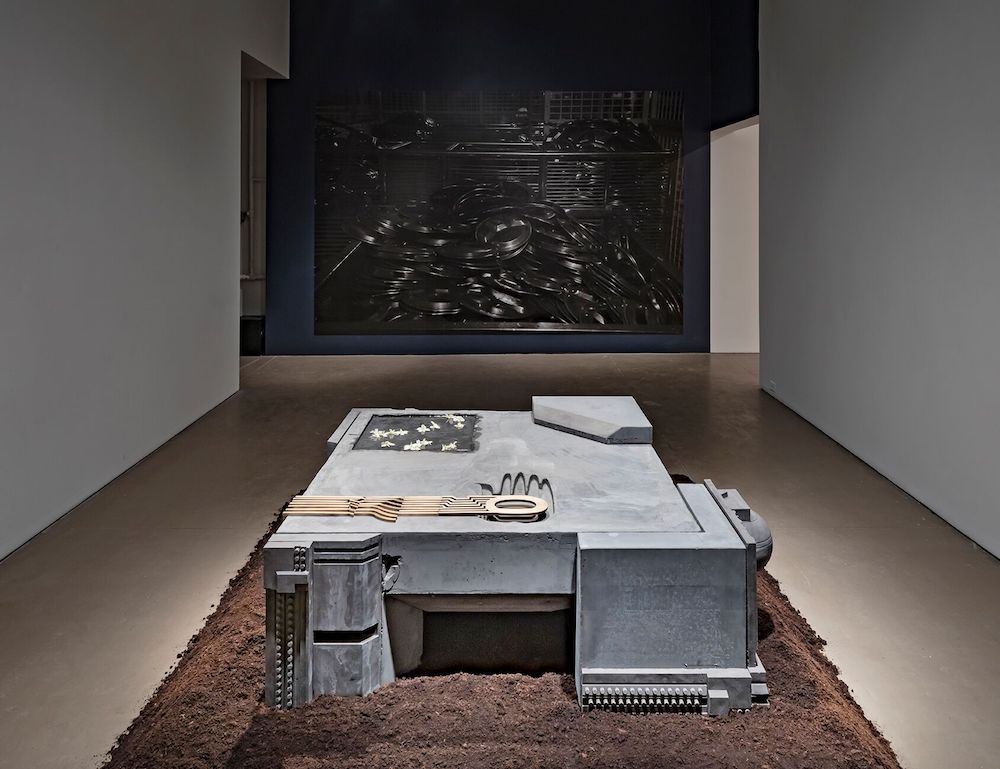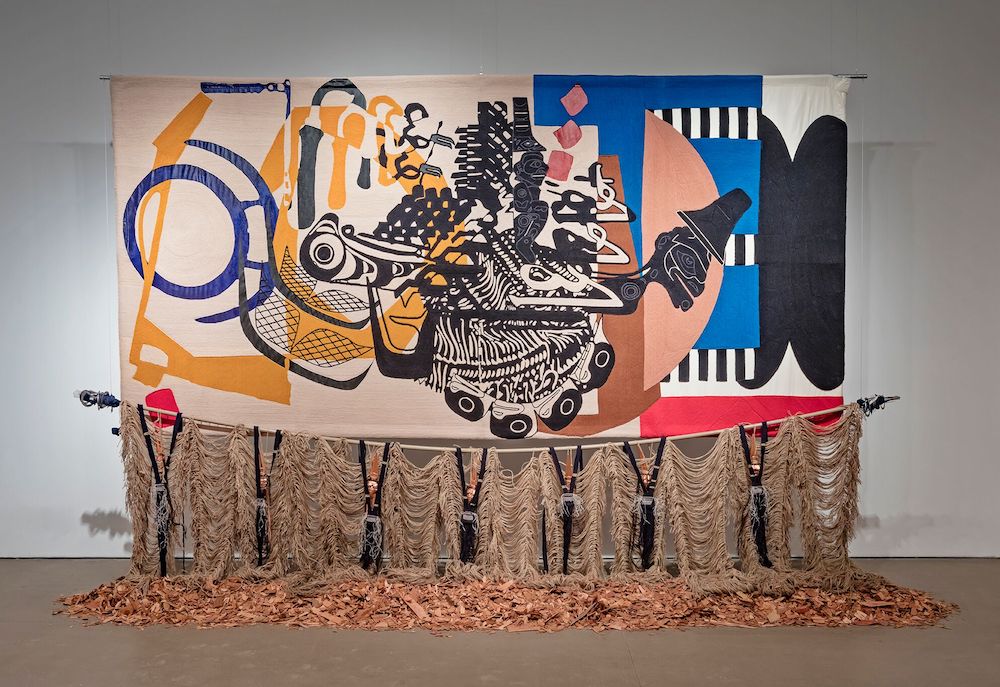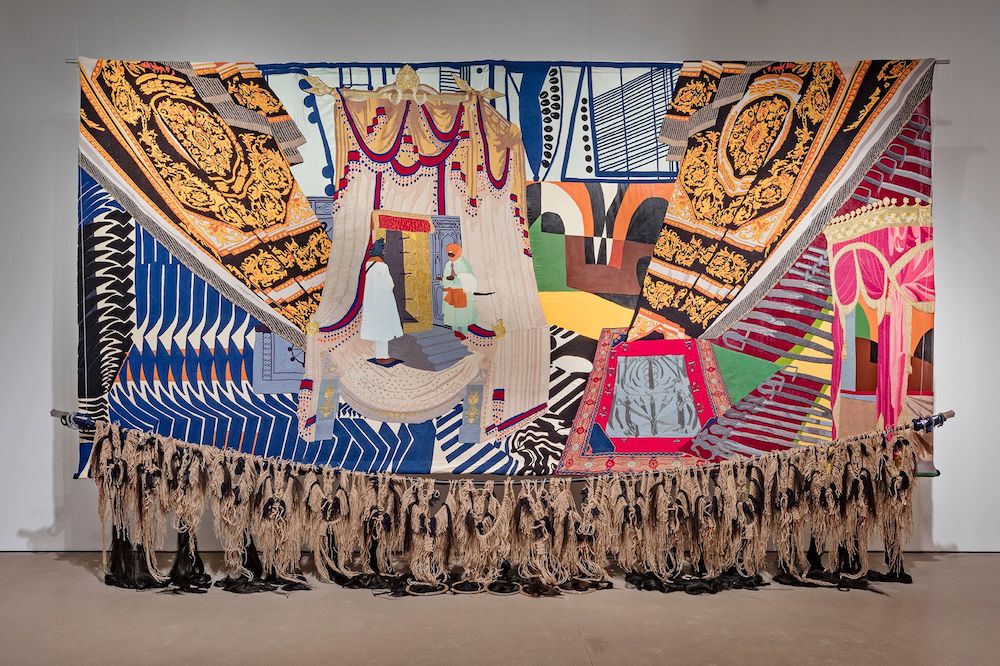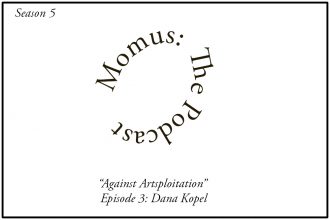To reconstitute memory that has been violently suppressed, we often turn toward the monumental, hoping to fill a discursive void with a profusion of symbols and images. Nep Sidhu’s Medicine for a Nightmare (they called, we responded) – which recently closed at Toronto’s Mercer Union, and travels next to Calgary’s Esker Foundation – engages with communal trauma in this mode. Comprising textiles, metalwork, sculpture, sound, and photography, Sidhu’s work steps into the contested terrain of collective memory, and reflects on the 1984 massacres of Sikh people at the hands of the Indian Government. Medicine for a Nightmare attempts to reconstitute an erased history and envision solidarity across gendered, racial, and communal lines. All this in the open and accepting spirit of Sikhism. However, critics from within the community have voiced concerns that the show’s framing references the far-right Khalistani movement: that it simplifies the historical narrative and obfuscates the breadth of violence inflicted by this fringe group. The disparity between these polar readings raises a crucial set of questions; as philosopher and art historian Rebecca Comay might put it, how do such forms of remembering compound injury on the living, and instrumentalize the dead? How do the systems of art’s circulation and commodification reinforce monolithic narratives of diasporic subjectivity? Most importantly, how can curatorial intervention disrupt these oppressive forms of knowledge production?
Medicine for a Nightmare evokes the legacy of Operation Blue Star, the Indian Army’s storming of the Harmandir Sahib, the holiest site in Sikhism, to flush out a fortified group of militants, led by Jarnail Singh Bhindranwale in 1984. Accounts vary as to the militants’ aims: some claim that they sought state policies that would protect the religious, linguistic, and economic rights of Sikhs; others argue that they demanded the establishment of a separate Sikh state known as Khalistan. In the ensuing violence, Bhindranwale was killed, along with scores of innocent pilgrims who had congregated at the temple (estimates vary between 1000 and 20,000). Then, in October of that year, Indira Gandhi was assassinated by her Sikh bodyguards, sparking anti-Sikh massacres, which were abetted by official complicity. In retaliation, diaspora Khalistani organizations like Babbar Khalsa International (led by Talwinder Singh Parmar, a Canadian citizen) coordinated several public atrocities. The most infamous of these was the 1985 bombing of Air India Flight 182, the deadliest terrorist attack in aviation history prior to 9/11, which left a profound impact on Canadian politics for decades to come. While the Khalistani movement is virtually non-existent in Punjab, its reverberations are keenly felt in Sikh life in the diaspora.
It’s impossible to definitively read references to Khalistan in Sidhu’s work, but the visual shorthand to code the work as Sikh can be read as implicitly referencing Khalistani rhetoric. The show’s central textile work, Medicine for a Nightmare (2019), is replete with martial regalia – swords, kirpans, katars, arranged in agitprop-style compositions that guide the visual movement of each work. Central to the composition are two Amritdhari (Khalsa initiated) men guarding the doors of the Hazūr Sāhib – one of the five seats of temporal authority in Sikhism. This iconography, however, is not neutral, as recent scholarship has explored. Through a complex series of historical and religious negotiations, Amritdhari men have become representative of a Sikh collectivity – in turn creating mechanisms for exclusion of non-Amritdhari Sikhs from aspects of civic and religious life. Further, as scholars like Brian Axel have pointed out, images of valorized Amritdhari men are circulated widely by Khalistani organizations on the internet. These are often juxtaposed with representations of violence inflicted on them by the Indian state, portraying them as martyrs in a bid to solicit allegiance to Khalistani politics. A work in the accompanying series of prints, Untitled, 7f (2019) explicitly references this cyber-archive. The print portrays Heera Singh Waryam, a Babbar Khalsa militant who was gunned down by the Punjab police in an instance of extrajudicial violence. A related web search yields one sparse entry in a book documenting police violence in Punjab and a plethora of websites that valorize Waryam’s connections with Jarnail Singh Bhindranwale and depict him as a martyr to the Khalistani cause. While it’s important to commemorate the thousands of victims of extrajudicial state violence in Punjab, this memorialization also obscures the violence and intimidation that Khalistani actors have inflicted on people who disagreed with their views. These include well-known Naxalite poet Pash, and Canadian Federal MP, Ujjal Dosanjh.
The hypervisibility of the male Amritdhari subject is contrasted in the work with the absence of female figures. In a photographic vinyl titled Seva, In Memory, In Practice (2019), which commemorates the (often gendered) labor of care in communal kitchens, women are notably missing – a fact sharply incongruous with history. During the Partition of India in 1947, lines between communities were inscribed through the rape and subjugation of women, and the widows of 1984 continue to be instrumentalized as vessels of performative remembrance. The exhibition’s bibliography cites Kamal Arora’s exploration of the “The Widow Colony” in Delhi as an example of this gendered history, but the reference reads like a footnote.

Nep Sidhu, “Medicine For a Nightmare (they called, we responded)” (Installation View), 2019. Image Courtesy of the Artist. Photo by Toni Hafkenscheid.
Beyond weapons and ornaments, Sidhu explores the poetic potential of his material, wootz steel. The psychedelic patterns that fill the background of Medicine for a Nightmare (2019) – the textile work which gives the exhibition its name – reference the clatter and din of metal plates being cleaned in communal kitchens to a constant percussive rhythm. This motif invokes memory, asserts resilience, and constitutes a meditative, restorative practice. Sidhu’s abstract gesture opens up a much-needed space for the open-ended work of healing. But even this goes challenged by a loud superimposition of culturally-encoded imagery: swords, regalia, arabesque draperies, and the two turbaned male figures. These signifiers end up reproducing an Orientalized visual rhetoric, obscuring the transformative potential of percussion as a bearer and activator of memory. The tapestry’s halfway turn toward abstraction perhaps assumes that without overt cultural signifiers, audiences would not be able to access the underlying narratives. This underestimates the curiosity and ingenuity of audiences and their ability to meet a challenge.
Early critiques of the exhibition pointed to omissions and errors in research, and took particular issue with the depiction of Jarnail Singh Bhindranwale – in the exhibition’s since-retracted text – as a “community leader,” rather than a radical right-wing preacher. In response, curator cheyanne turions issued a bibliography with a foreword recognizing “the events of 1984 encompass myriad violences directed toward Sikh people and it is important to acknowledge this entwined complexity.” The text emphasizes that the work speaks to an individual encounter with a long and violent history of oppression. But the public nature of these depictions of shared trauma renders this retreat to subjectivity and curatorial neutrality inadequate. Curators of work like this must be accountable to the history on which it comments, and offer the necessary tools to encounter representations of violence. Absent the necessary context, we default to positioning the diasporic artist as a native informant, mediating the reading of a community’s history by a white mainstream audience. The work becomes reduced to a narrative of absolution: perpetuating a celebratory myth of a model minority persisting through adversity.
Incautious writing can also reinforce this mythology. The textile works in Sidhu’s exhibition are, as is the norm in contemporary projects of this scale, created by workshops in New Delhi, and then assembled by a team of artists in Canada. However this labor finds no mention in the exhibition text or most reviews of the work – all of which position Sidhu as a lone creator. They largely fetishize the diaspora artist as an orientalized alchemist creating magic objects. Even as the works comment on shared labor and “the spiritual role of tending to life in common,” the texts substitute the individual artist as a stand-in for a collective. In this way they flatten the presented narrative of communal trauma and paper over its discontinuities.
Anger over the injustices of 1984 serves as an important lightning rod for more local concerns among Sikh diaspora: disproportionate targeting by police, hate crimes, and racial stereotypes. Attuned to this, Medicine for a Nightmare attempts to connect with other oppressed and marginalized communities in the open and accepting spirit of Sikhism. Collaborating with Nicholas Galanin in Axes in Polyrhythm (2019), Sidhu builds on the exhibition’s motif of percussion, here manifested in Galanin’s carving of a totem pole, whose cedar chips line the floor. The abstraction, however, is somewhat obscured by an overwrought series of West Coast mythological figures and ovoid motifs. For another collaboration, a series of busts with Maikoiyo Alley-Barnes, Sidhu attempts to forge a historical connection through a shared history of metallurgy. In their display however, Barnes’s sculptures become little more than armatures for displaying Sidhu’s ornamental metalwork, leaving their potential for dialogue and solidarity unrealized. Proximity to Blackness and Indigeneity is not the same as solidarity, and pointing to aesthetic similarities is a largely symbolic and passive way of drawing intercommunity connections. Active, sustained solidarity requires the dismantling of internal hierarchies of class, colorism, and learned anti-Blackness. In lieu of this, these gestures ring with a hollow performativity.

Nep Sidhu with Nicholas Galanin. “Axes in Polyrhythm,” 2018. Image Courtesy of the Artists. Photo by Toni Hafkenscheid.
Annotating the lapses in historical narrative presented in Medicine for a Nightmare can seem an elaborate exercise in whatabout-ism. There will always be fissures when memory is reconstituted, and – as the exhibition bibliography argues – it’s unreasonable to burden an artist with impossible expectations of complete representation. But where the exhibition fails, there is generative potential. The show engaged new publics in the gallery with an energy that felt transformative. In the course of two public events that I attended as part of the exhibition program, there was a noticeable attempt to rectify gaps in the narrative. However, discussion about the political implications of the work were kept to a minimum. In defence of the show, Rachna Raj Kaur writes about its potential to catalyze conversations around 1984 and its long shadow, an invective repeated throughout the events. But the depth of this conversation is limited by its context, including the relatively new visibility of Sidhu in the white artworld; the persistent tendency of Canadian media to peddle racist narratives about Sikh people (and the Khalistan issue in particular); and the relative lack of informed institutional actors. These limitations mean that the inconsistencies in the work largely go unchallenged, and representation becomes flattened and instrumentalized in the service of settler-colonial agendas. There are beginnings, in Sidhu’s work, of transformational and poetic means of healing and empathy. However, in order for these strategies to be realized, the work (and its framing) must search for more radical means of disruption within the standard narrative and create ever more space for a multiplicity of voices.


























From one art-writer to another: I can’t help but feel that this piece is more about criticism for criticism’s sake than a genuine attempt at engaging with Nep Sidhu’s work. Where is your pleasure in viewing? And where is your respect for the experience of the artist?? This was a materially-rich, beautifully layered, ambitious, and powerful exhibition. It used art and the spirit of collaboration to suggest that a traumatic history can be transformed into a process of healing and communal empowerment. To criticize it as an imperfect total summation of the entire complex history the Sikh experience in India is to presume that art has the responsibility to deal with everything or nothing at all. This is one exhibition within the greater trajectory of an artist’s practice, and any criticism should at least be balanced with some attempt at actually reading the work, rather than simply delivering a highly-researched series of facts using the tired rhetoric of elitist academia.
EXACTLY!!!